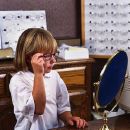|
- You should always avoid touching your eyes and make sure that you thoroughly wash your hands before touching
your face.
- The eyes grow and change quickly in the first few years of life. Regular
eye examinations are important to make sure a child’s eyes and vision are developing normally. If problems are found
early, they can be treated before any damage is done to the child’s vision including permanent
loss of vision.
Eye Exams

If you're having trouble with your vision, your mom or dad can take you for an eye exam.
This might happen as part of your regular checkup at the doctor. But you need to see a vision specialist if your parents or
your doctor think you might need glasses.
You might see an ophthalmologist, optometrist, or an optician. What's the difference? An
ophthalmologist is a doctor trained to treat vision problems who may also do eye surgery.
An optometrist is a licensed professional who specializes in eye exams and in figuring
out the right prescriptions for eyeglasses and contact lenses. Opticians make or sell eyeglasses and contact lenses according
to an ophthalmologist's or optometrist's prescription.
At your eye exam, you'll probably be asked to read from an eye chart. This is the chart
with letters in different sizes. You also might be asked to look at some text up close, like reading from a book. These tests
measure how well you see from close and from far away.
If you need glasses or contact lenses, there's a special gizmo that lets you try a few
different prescriptions until you find the one that gives you the clearest vision. It's kind of like a big pair of glasses,
but a bunch of different lenses can be switched in and out really quickly.
The person doing your eye exam may switch between two different lenses and say, "Like this
or like this?" You'll have to say which one looks clearest. If you're not sure, say so. Remember, the idea is that you get
the right prescription so your vision will be top-notch!
What is a lazy eye and how is it treated?
The term "lazy eye" is a misnomer for poor vision in one eye, though
the eye appears to be normal. If a condition causes a child to favor one eye, poor vision might occur in the eye that is not
being used. The medical term for this condition is amblyopia.
Amblyopia is reversible in the first nine to 10 years of life but is
best treated very early. The younger the child is at the beginning of therapy, the faster the recovery of vision. It is important
that when you have problems seeing or are prone to repeated eye infections that you see a doctor or school nurse.
What Is Conjunctivitis?
Conjunctivitis (say: kon-jung-tih-vy-tis) is the most common eye problem kids can have. It can cause redness, itching, inflammation (say: in-fla-may-shun) or swelling, and a clear or white, yellow, or greenish
gooey liquid to collect in the eyes.
It's called
pinkeye because the white part of the eye and inside the eyelids become red or pink when you have it. Pinkeye may start in
one eye, but many people get conjunctivitis in both eyes at the same time. Conjunctivitis usually doesn't hurt, but itching
can be annoying. Sometimes it feels like you have an eyelash or a speck of sand in your eye and can't get it out.
Conjunctivitis
lasts a short time, usually about a week or less, and then goes away by itself or after treatment, permitting that you do
not continue to touch the eye and make sure to keep the area clean.
You can
get conjunctivitis by touching the hand of an infected friend who has touched his or her eyes. If you then touch your eyes,
the infection can be spread to you. Washing your hands often with warm, soapy water is the best way to avoid being infected with conjunctivitis.
Kids also
get conjunctivitis because of allergies or because they get something irritating in their eyes, but these kinds of conjunctivitis
are not contagious.
What Should I Do if I Think I Have It?
If your eyes are itchy, red, or more crusty than usual in the
morning, you should tell a parent. Don't wait, because conjunctivitis spreads easily. Your mom or dad probably will
call the doctor for an appointment.
|